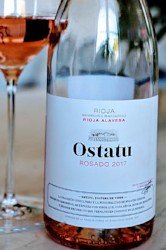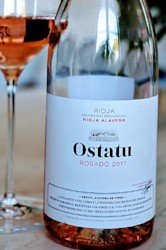
OSTATU | Rosado 2017
(Rioja, Spain) $15
 Is there anyone left who hasn’t become a rosé drinker? (Rosé’s multi-year meteoric rise in sales makes that hard to imagine). Around our office, we taste scores and scores of good rosés, but this wine really knocked us out. It’s from the Alavesa, the best part of Rioja, and its taut minerally flavors are racy, sophisticated, and delicious. The top Spanish rosés (rosados), by the way, are some of the most exciting in Europe. Ostatu rosé tastes like it costs a lot more than it does. Don’t you need a refreshing summer staple? (13.5% abv)
Is there anyone left who hasn’t become a rosé drinker? (Rosé’s multi-year meteoric rise in sales makes that hard to imagine). Around our office, we taste scores and scores of good rosés, but this wine really knocked us out. It’s from the Alavesa, the best part of Rioja, and its taut minerally flavors are racy, sophisticated, and delicious. The top Spanish rosés (rosados), by the way, are some of the most exciting in Europe. Ostatu rosé tastes like it costs a lot more than it does. Don’t you need a refreshing summer staple? (13.5% abv)
90 points KM
Available at Vintage 38

Mataro, zibbibo, and mazuelo are also known as:
A. muscat, chenin blanc, and malbec
B. zinfandel, roussanne, and tempranillo
C. mourvèdre, muscat, and carignan
D. merlot, vermentino, and sangiovese

It Takes Two to Be Tangy
It’s spring, and for me, that means it’s time to drink a ton of Sancerre and Pouilly-Fumé, still among the two best wines in the world for salads and green vegetables like spring peas and asparagus. And there’s another reason I love Sancerre and Pouilly Fumé: goat cheese. The tangy/creamy/chalky/salty flavor of most goat cheeses can make red wine taste hollow. But Sancerre and Pouilly-Fumé are perfect with goat cheeses in part because they are so tangy themselves. In particular, the combination of Sancerre and Crottin de Chavignol, a small disk of goat cheese from the village of Chavignol, is considered to be a classic French marriage. (Crottin, by the way, is French slang for goat turd).


“The minor miracle of wine is that it has evolved to the point where alcohol is perhaps the last element that gets the wine lover drunk. With wine, from a particular place and vintage, we can get drunk on history; anyone who has drunk a great wine twice their age will immediately relate to this. We can get drunk on place, recalling memories and associations with the region in which the wine was made. We can get drunk on remembrance: each wine naturally reminds us of previous occasions when it or similar wines were consumed, and this in turn can evoke countless memories of friends, meals and times past. Of course, wine lovers can get drunk purely on the lifted perfume of a great bottle or the textured, velvety mouthfeel and lingering flavors that scent the breath after swallowing.”
—Robert Walters, “The Wine of Astonishment” The World of Fine Wine, Issue 22

The highest vineyard in the world is in Argentina.
Answer: True. Although wine is now made in the Himalayas in China and more vineyards there in the future could change this answer, currently, the highest vineyard in the world is in Argentina. Bodega Colomé at 10,200 feet in altitude (3,111 meters) is in the northern part of that country’s Calchaqui Valley. At that altitude, luminosity is intense and the grapes tend to develop thicker skins, although the direct impact on flavor is not known.








